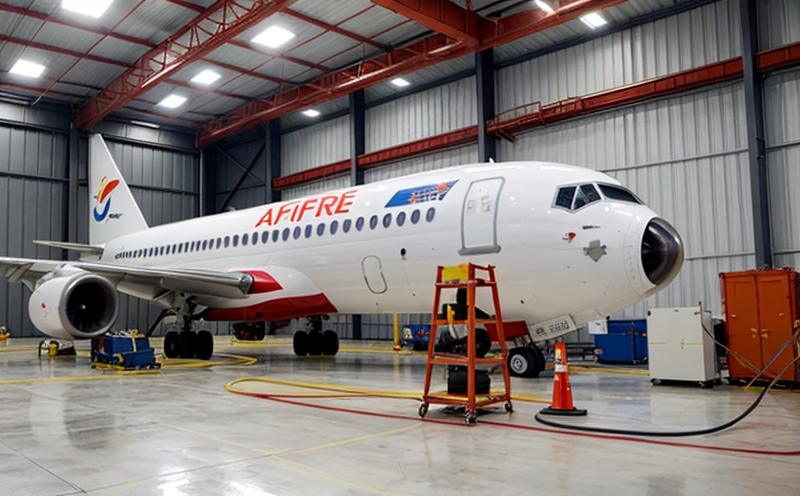Fire Resistance Testing of Overhead Compartments
The aerospace industry places stringent requirements on materials and structures to ensure safety in case of fire. Fire resistance testing of overhead compartments is a critical aspect of this process, ensuring that these vital components can withstand the intense heat and flames encountered during an emergency situation. This test evaluates how well overhead compartments maintain their structural integrity and prevent the spread of fire under specified conditions.
The purpose of such testing is to identify potential weaknesses in materials and designs used in aerospace applications. By subjecting specimens to controlled fire exposure, engineers can assess the performance of various materials under stress. The aerospace sector relies heavily on fire-resistant materials due to the highly flammable nature of aircraft interiors, including fabrics, foams, and plastics.
The testing process typically follows international standards like ISO 7238 or ASTM E1695, which provide guidelines for simulating real-world fire scenarios in a laboratory setting. These standards ensure that tests are consistent across different manufacturers and laboratories, enhancing the reliability of results. The test setup involves placing a specimen within an overhead compartment, subjecting it to controlled heat sources, and monitoring its behavior throughout the duration of the test.
One key parameter is the temperature at which the sample begins to show signs of deterioration. This can include melting, charring, or loss of structural stability. Another critical factor is the time required for flames to penetrate through the specimen into adjacent compartments. The goal is to establish a safe margin that ensures passengers and crew have sufficient time to evacuate in case of an emergency.
Specimen preparation involves selecting materials representative of those used in actual overhead compartments. This may include laminates, composites, or any combination of fire-retardant substances. Once prepared, the specimens are carefully placed into the testing apparatus designed specifically for this type of evaluation. The apparatus includes a chamber capable of maintaining precise temperature and flame conditions.
The test duration varies depending on the specific standards being adhered to but generally lasts between 15 minutes and an hour. Throughout the test, various sensors continuously monitor changes in temperature, smoke levels, and structural integrity. These data points are crucial for determining whether the specimen meets safety requirements.
After completing the test, analysts review all collected data to draw conclusions about the material's fire resistance capabilities. If necessary, adjustments can then be made to improve performance before final certification. Compliance with these rigorous standards is essential not only for maintaining public trust but also for meeting regulatory obligations imposed by aviation authorities worldwide.
In summary, fire resistance testing of overhead compartments plays an indispensable role in safeguarding passengers and crew members during emergencies aboard commercial aircrafts or military helicopters. Through meticulous application of scientific principles and adherence to international norms, this procedure helps ensure that even under extreme conditions, these critical structures remain effective barriers against spreading fires.
Benefits
- Ensures compliance with aviation safety regulations
- Promotes passenger safety in case of emergencies
- Enhances reliability and longevity of overhead compartments
- Reduces risk of fire spread within the aircraft cabin
- Facilitates continuous improvement through rigorous testing protocols
- Supports development of safer materials for use in aerospace applications
- Aids in meeting international standards recognized by aviation authorities
- Improves overall product quality and reduces liability risks
Why Choose This Test
- Comprehensive assessment of material properties under controlled fire conditions
- Accurate representation of real-world scenarios for more reliable results
- Strict adherence to industry-leading standards ensuring consistency and accuracy
- Detailed reporting providing valuable insights into performance characteristics
- Expertise in conducting complex tests with state-of-the-art facilities
- Prompt turnaround times for quicker feedback on design modifications
- Support from experienced professionals who understand the unique challenges faced by aerospace manufacturers
- Cost-effective solutions tailored to meet specific project needs without compromising quality
International Acceptance and Recognition
The fire resistance testing of overhead compartments is widely recognized as a crucial step in ensuring passenger safety aboard commercial aircraft. This test not only meets the stringent requirements set forth by aviation authorities but also complies with globally accepted standards such as ISO 7238, ASTM E1695, and EN 45545-2. These standards ensure that all testing procedures follow best practices established through extensive research and practical application.
Aviation agencies around the world rely on these standardized tests to verify that materials used in overhead compartments will perform reliably during emergencies. For instance, the Federal Aviation Administration (FAA) in the United States mandates compliance with certain fire safety measures outlined in Part 25 of its regulations. Similarly, the European Union's aviation authority, EASA, requires manufacturers to demonstrate adherence to specific criteria for fire resistance.
By choosing this test, organizations can leverage their results across multiple markets, reducing costs associated with repeated testing and certification processes. Additionally, successful completion of these tests enhances an organization's reputation, potentially attracting more business opportunities both domestically and internationally.
In conclusion, the international acceptance and recognition of fire resistance testing underscore its importance in maintaining high standards within the aerospace industry. As global aviation continues to grow, so too does the need for robust safety measures that protect lives and property. Organizations committed to excellence should consider incorporating this testing into their quality assurance programs to stay ahead of regulatory changes and maintain competitive advantage.





